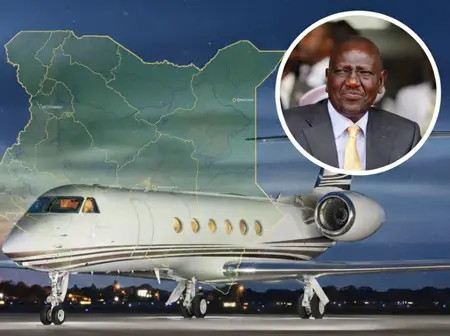As African leaders began trickling in for the second Africa Climate Summit (ACS), a long white silhouette dropped through the haze and settled on the VIP apron.
Out stepped President William Ruto, immaculate in navy suit, while a brass band struck up the Kenyan anthem. Behind him, the gleaming Gulfstream GV, tail number T7-VVV, sat engine-idle, its oval windows reflecting the honour guard like rows of polished mirrors.
The optics were smooth diplomacy; the invoice waiting back home would prove bumpier.
The 29-metre jet is 28 years old but still one of the most capable business aircraft ever built. Powered by two Rolls-Royce BR710 turbofans, it can haul 14–18 passengers and their luggage 12 000 km non-stop – think Nairobi–Washington or Singapore – London without refuelling.
Sunday’s mission was shorter: a 1 h 40 min hop from Wilson Airport to Bole International Airport, a distance Kenya Airways serves seven times a week for about KES 60,000 in economy and KES 180,000 in business.
President @WilliamsRuto has arrived in Addis Ababa, Ethiopia, for the second Africa Climate Summit (ACS). Kenya hosted the inaugural ACS in September 2023.
The second ACS aims to position Africa as a global climate solutions’ leader by accelerating African led adaptation,… pic.twitter.com/oa1tkBpo7Z
— State House Kenya (@StateHouseKenya) September 7, 2025
Charter brokers say a GV costs about US $15,000 – 20,000 (KES 1.9 – 2.6 m) per flight-hour; add positioning, crew overtime, Ethiopian over-flight fees and a two-night stay, and Treasury is likely to book something close to KES 10 million for the round trip.
That is more than five times what the national carrier would have charged if Ruto had taken an similar-sized delegation in business class, as he did in private. It is also the third high-profile private jet the president has used in 18 months.
In May 2024 he flew to Atlanta and Washington on a Boeing 737-700 business liner; in November he chartered a Bombardier Global 7500 to Dubai for COP28. Each time, social media erupted over cost; each time State House insisted the bill was “heavily subsidized by friends” and that Kenya Airways quotations were “prohibitively high”.
The GV is operated by Skymark Executive, a San-Marino-registered company run by Lebanese captain Farid Gharzeddine.
Skymark’s website shows the aircraft was “permanently repositioned to Nairobi in October 2024 to meet surging VIP demand across Africa”.
Civil-aviation records list only one Gulfstream V in its fleet, alongside a 13-year-old G450 and a 2021 G600 domiciled at Al-Maktoum International in Dubai. The GV is hangared at Wilson Airport, making it the only aircraft of its type locally available for ad-hoc presidential charters.
Convenience comes at a delicate moment. On 3 September Controller of Budget Margaret Nyakang’o tabled a quarterly report showing that State House had withdrawn KES 3.6 billion between 14 May and 24 June 2025 under Article 223 of the Constitution, the clause that lets the executive spend first and seek parliamentary approval later.
Of that, KES 1.25 billion was never submitted to her office for review. Daily hospitality spending alone averaged KES 3 million; total domestic travel hit KES 25.4 billion for the financial year, only marginally below the previous cycle despite repeated pledges to cut non-essential expenditure.
Treasury has since frozen new civil-service hires and asked ministries to scrap workshops and stay in three-star hotels.
Ruto’s aides argue that presidential logistics cannot be benchmarked against commercial fares; security protocols, communications gear and last-minute schedule changes require dedicated aircraft.
Despite that assertion, pictorial evidence of the jet was conspicuously missing from both the President and State House X accounts, with the one closest photo just happening to face the other way. Typically, the welcome handshake right after descending the airplane staircase is the main picture.
KOX had to scour Ethiopian sources for an image.
With this being a climate summit, perhaps a gesture of flying commercial – where a passenger’s CO2 emissions can be over 5 times lower – would have gone a long way.
While not worse in its class, the Gulfstream GV is still a terrible emitter.

Leave a Reply